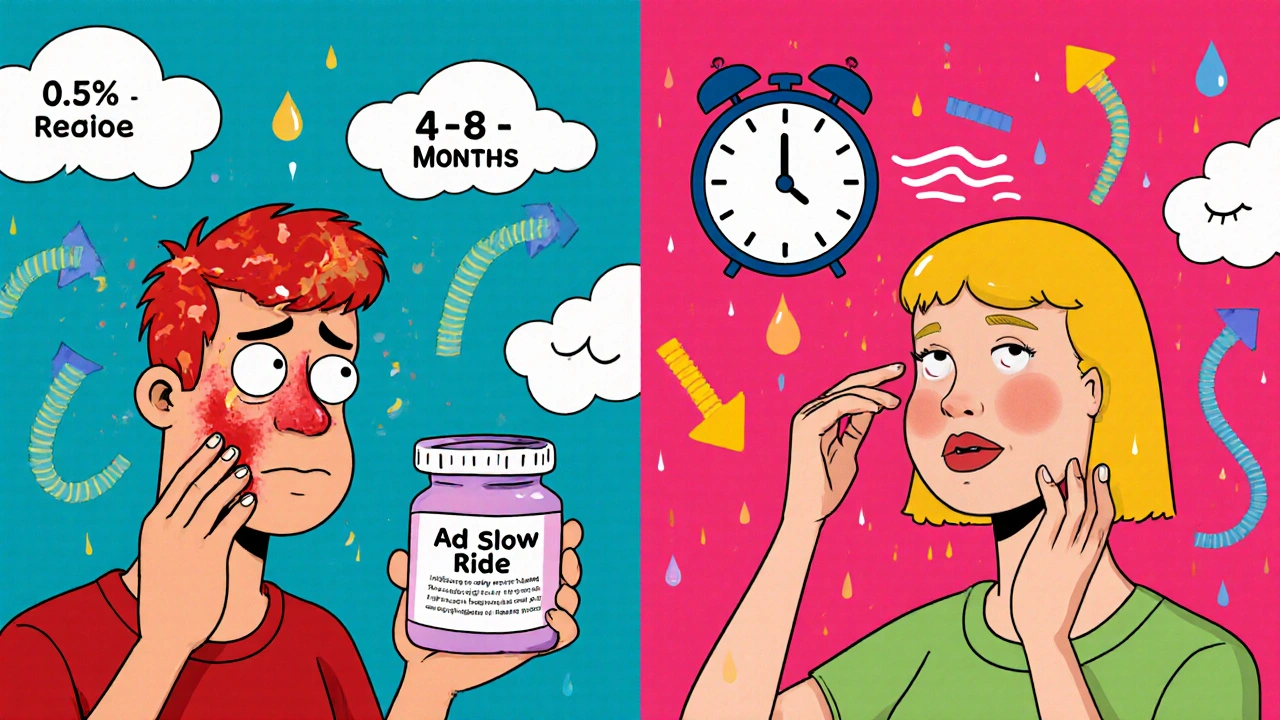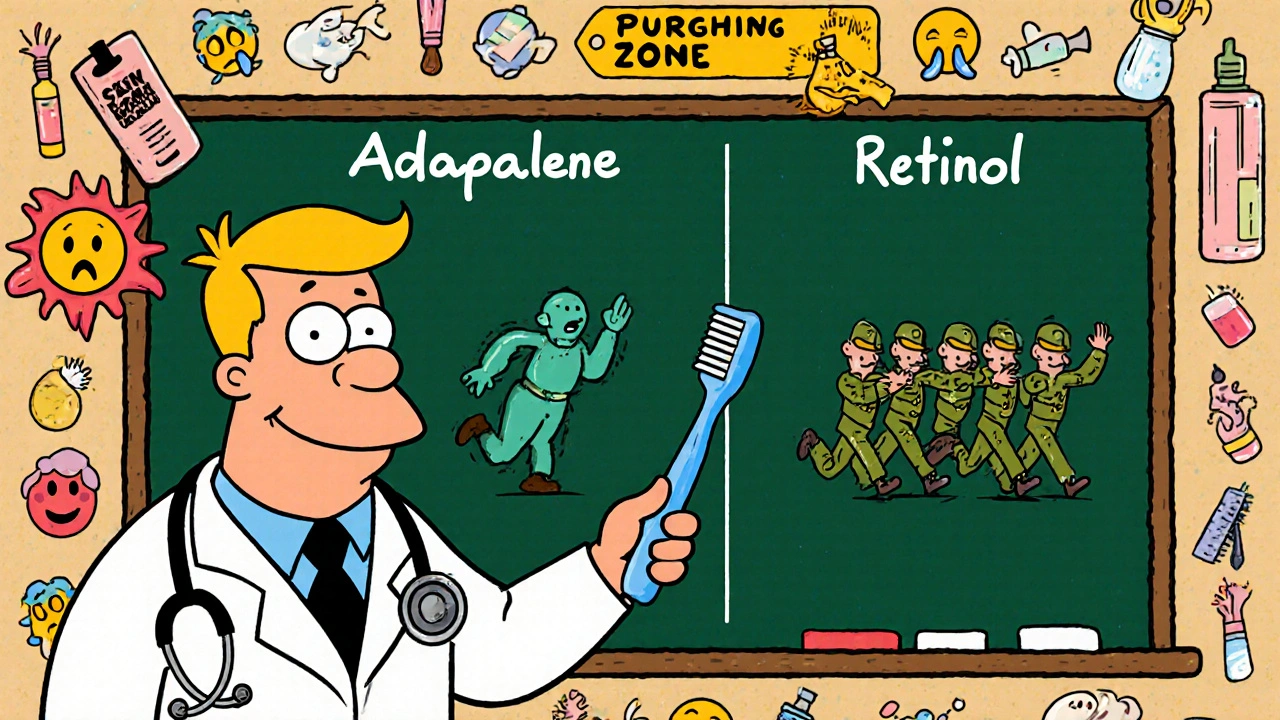Acne doesn’t just show up on your face-it shows up in your confidence, your social life, your morning mirror routine. You’ve tried cleansers, spot treatments, even over-the-counter benzoyl peroxide. Nothing sticks. Then you hear about adapalene and retinol. Both are retinoids. Both promise clearer skin. But which one actually works better for your acne? And more importantly, which one won’t turn your face into a dry, flaky mess by week two?
What Is Adapalene?
Adapalene is a third-generation retinoid developed specifically for acne treatment. It was first approved by the FDA in 1996 and is now available over the counter in 0.1% strength in the U.S. and Australia under brand names like Differin. Unlike older retinoids, adapalene targets acne at the root: it unclogs pores, reduces inflammation, and stops new pimples from forming before they break the surface.
It’s not just a surface cleaner. Adapalene works deep inside the hair follicle, where dead skin cells and oil build up and trap bacteria. It normalizes skin cell turnover so cells don’t stick together and block pores. This means fewer blackheads and whiteheads over time. Studies show that consistent use of 0.1% adapalene reduces inflammatory acne lesions by up to 60% in 12 weeks.
It’s also gentler than tretinoin, the original prescription retinoid. While tretinoin can cause intense peeling and redness, adapalene has a lower irritation potential. That’s why dermatologists often recommend it as a first-line treatment for mild to moderate acne-especially for people with sensitive skin.
What Is Retinol?
Retinol is a form of vitamin A found in many over-the-counter skincare products. It’s not just for acne-it’s used for anti-aging, brightening, and improving skin texture. But it does work on acne too.
Retinol converts into retinoic acid inside the skin, which is the active form that regulates cell growth and reduces oil production. But here’s the catch: it’s not as direct as adapalene. Your skin has to convert retinol into retinaldehyde, then into retinoic acid. That conversion process is inefficient-only a small percentage of the retinol you apply actually becomes active.
That’s why retinol products often need higher concentrations (0.3%, 0.5%, even 1%) to show results. Even then, it can take 3-6 months to see a noticeable drop in acne. And because it’s less targeted, it’s more likely to cause irritation, especially if you’re using it alongside other actives like salicylic acid or vitamin C.
Adapalene vs. Retinol: The Direct Comparison
Let’s cut through the marketing. Here’s how adapalene and retinol stack up when it comes to treating acne.
| Feature | Adapalene | Retinol |
|---|---|---|
| Active Form | Retinoic acid (direct-acting) | Requires conversion to retinoic acid |
| Strength (OTC) | 0.1% | 0.1%-1% |
| Time to See Results | 4-8 weeks | 3-6 months |
| Targets Inflammation | Yes | Moderately |
| Pore-Clogging Prevention | Strong | Moderate |
| Irritation Risk | Low to moderate | Moderate to high |
| Best For | Inflammatory acne, sensitive skin | Mild acne, anti-aging combo |
If your main goal is clearing active breakouts-especially red, swollen pimples-adapalene wins. It’s faster, more targeted, and less likely to irritate. Retinol? It’s a jack-of-all-trades. It helps with acne, but it’s slower, and if you’re using it just for acne, you’re leaving performance on the table.

Why Adapalene Is the Better Choice for Most Acne Cases
Let’s say you’re 22, you’ve had cystic breakouts every month for the past year, and your dermatologist says you don’t need antibiotics. You want something that works without a prescription. Adapalene is your best bet.
A 2023 study in the Journal of Clinical and Aesthetic Dermatology followed 217 people with moderate acne using 0.1% adapalene gel daily. After 12 weeks, 78% reported a 50% or greater reduction in inflammatory lesions. Only 12% discontinued due to irritation.
Compare that to retinol: a 2022 trial using 0.5% retinol cream showed only 41% of participants saw a 50% reduction after 24 weeks. And 29% quit because of redness and peeling.
Adapalene also has a built-in anti-inflammatory effect. It lowers levels of IL-6 and TNF-alpha-chemicals that trigger redness and swelling in acne. Retinol doesn’t do this directly. It helps indirectly by improving skin turnover, but it doesn’t calm the fire the way adapalene does.
If you have hormonal acne, rosacea-prone skin, or just get irritated easily, adapalene is the safer, smarter pick.
When Retinol Might Still Be Worth It
There’s a reason retinol is everywhere: it does more than acne. If you’re in your late 20s or 30s and your acne is mostly mild-just occasional blackheads and a few small pimples-retinol can handle both acne and fine lines at the same time.
It thickens the dermis, boosts collagen, and fades post-acne marks. If you’re already using it for anti-aging and your acne is under control, there’s no need to switch. But if your acne is active, inflamed, or stubborn, retinol alone won’t cut it.
Also, if you’re on a budget, retinol products are cheaper. You can find a decent 0.5% retinol cream for $15. Adapalene gel (Differin) costs $25-$40. But remember: you’re paying for effectiveness. Adapalene works faster, so you’re less likely to waste money on products that don’t deliver.
How to Use Them Right (Without Ruining Your Skin)
Both can irritate your skin if you use them wrong. Here’s how to start without triggering a flare-up.
- Start slow. Use it every other night for the first two weeks. If your skin feels fine, go nightly.
- Apply to dry skin. Don’t slap it on right after washing. Wait 20 minutes after cleansing.
- Use a pea-sized amount for your whole face. More doesn’t mean better.
- Always use sunscreen. Both increase sun sensitivity. SPF 30+ daily, non-negotiable.
- Don’t mix with harsh exfoliants. Avoid physical scrubs, high-strength AHAs, or benzoyl peroxide right after application. Use them in the morning instead.
- Moisturize. Use a simple, fragrance-free moisturizer. Ceramide-based ones work best.
For adapalene: You can use it with niacinamide. In fact, studies show niacinamide reduces irritation and boosts acne clearance when paired with adapalene.
For retinol: Avoid combining with vitamin C in the same routine. Use vitamin C in the morning, retinol at night.

What to Expect in the First Few Weeks
Don’t panic if your skin gets worse before it gets better. That’s called purging. It’s not an allergic reaction-it’s your skin speeding up cell turnover and pushing out clogged pores. You’ll see more pimples, maybe even small whiteheads popping up. That’s normal.
Purging usually lasts 4-6 weeks. If after 8 weeks you’re still breaking out badly, or your skin is red, burning, or peeling nonstop, you’re probably overdoing it. Dial back to twice a week. If it doesn’t improve, stop and see a dermatologist.
Adapalene causes purging less often than retinol. That’s another reason it’s preferred for sensitive skin.
When to See a Dermatologist
Adapalene and retinol are great, but they’re not magic. If you’ve been using adapalene daily for 12 weeks and your acne hasn’t improved by at least 50%, it’s time to talk to a doctor.
You might need:
- Prescription-strength adapalene (0.3%)
- A combination treatment (like adapalene + benzoyl peroxide)
- Oral antibiotics or hormonal therapy (especially for women with cyclical breakouts)
Don’t keep pushing a product that isn’t working. Acne is treatable-but only if you’re using the right tool for your skin.
Final Verdict: Adapalene Wins for Acne
Retinol is great for anti-aging. Adapalene is built for acne.
If your goal is clear skin, fast results, and minimal irritation, adapalene is the clear winner. It’s more potent, faster-acting, and better tolerated than retinol for acne specifically. Retinol? It’s a bonus if you’re already using it for wrinkles. But if you’re starting from scratch with acne, don’t waste time on it.
Start with 0.1% adapalene gel. Be patient. Be consistent. Protect your skin from the sun. And give it at least two months before you judge it. Most people see real change by week 8.
Clear skin isn’t about finding the most expensive product. It’s about using the right one-and sticking with it.
Can I use adapalene and retinol together?
No, don’t use them together. Both are retinoids and will over-stimulate your skin, leading to severe irritation, peeling, and redness. Pick one. Adapalene is better for acne. Retinol is better for aging. If you want both benefits, use adapalene at night and a gentle vitamin C serum in the morning.
Is adapalene stronger than retinol?
Yes, in terms of acne treatment. Adapalene is a direct-acting retinoid that binds to skin receptors more efficiently than retinol. Retinol must convert into retinoic acid to work, and your skin does this slowly and inconsistently. Adapalene skips that step, making it more potent for clearing acne at lower concentrations.
Does adapalene help with acne scars?
It helps prevent new scars by reducing inflammation and preventing deep breakouts. But it doesn’t fade existing scars well. For post-acne marks (dark spots), pair adapalene with niacinamide or azelaic acid. For true scarring (indented or raised), you’ll need professional treatments like microneedling or laser.
How long does adapalene take to work?
Most people see improvement in 4-8 weeks. By week 12, acne lesions are typically reduced by 50-70%. Don’t expect overnight results. Acne treatments take time. If you stop after 2 weeks because your skin feels dry, you’ll never get to the clear skin phase.
Can I use adapalene if I have sensitive skin?
Yes, adapalene is actually one of the gentlest retinoids available. It’s formulated to minimize irritation while still working effectively. Start with every other night and use a soothing moisturizer. If you experience burning or flaking, reduce frequency. Most sensitive skin types tolerate adapalene well after a few weeks of adjustment.


Melvin Thoede
I started adapalene 3 months ago and my skin has never been this clear. No more red angry bumps before my period. I was skeptical at first but now I’m obsessed. Seriously, if you’re on the fence - just try it. Your future self will thank you.
Also, use a ceramide moisturizer. Game changer.